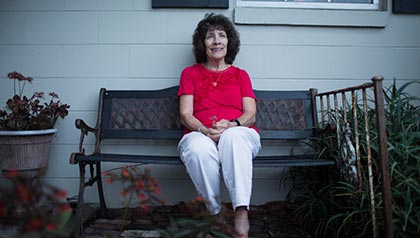AARP Hearing Center

By Jennie Hess • It may not seem like much, but an extra $16 a month makes a difference when Cynthia Aitcheson, 81, shops for groceries.
“It helps for at least a week,” said Aitcheson, who is among the 681,000 Floridians 60 and older whose income may be low enough to qualify them for the Supplemental Nutrition Assistance Program (SNAP), formerly called food stamps.
Various food aid programs
This summer, a group of AARP volunteers began working to help more people like Aitcheson apply for SNAP. About a third of eligible Floridians 60 and older do not receive the benefit. Volunteers are also informing Greater Orlando residents 50 and older about other help, such as food banks, meals in group settings and home-delivered meals.
“Seniors often find it more comfortable to discuss their challenges around food with volunteers who are near their own age,” said Dave Krepcho, president and CEO of Second Harvest Food Bank of Central Florida, a nonprofit that distributes donated food to more than 500 feeding programs in six central Florida counties.
“Pensions aren’t enough. People are trying to live on Social Security,” he said. “Every day that goes by, it’s a silver tsunami that’s hitting us.”
Second Harvest trained about 20 AARP volunteers in central Florida about SNAP and other food assistance programs so they could help other older people apply for the benefits.
One of those volunteers, Helen Jones, 83, of Winter Park, has met aging people whose cupboards are bare, including many who don’t realize they might qualify for SNAP.
People 60 and older living alone may qualify if their net monthly income is $931 or less, excluding most pensions; in two-person households, the allowed income is $1,261. Some assets, such as a home and some savings, are not included in the eligibility rules.
‘Just like a credit card’
AARP volunteers also try to alleviate the concerns of a generation that often is embarrassed to accept help, especially if friends and neighbors are aware of it. Aitcheson had the same concern until she used the SNAP card.
“It’s just like a credit card. You slide it through the machine, and you just punch in your numbers and sign,” she said. “It’s much easier, and nobody is looking at what you’re doing.”
Jones talks about SNAP to groups, distributes brochures and, if asked, helps people with the application process.
“I hear about [hunger] every day from senior groups, how many people they’re serving and how the numbers are growing rapidly,” Jones said. “Sometimes there’s not enough food to go around. I would do anything to help.”
In addition to SNAP, other programs can help older people who can’t afford or can’t prepare nutritious meals, said Abby Walters, AARP Florida associate state director for advocacy.
With the help of nearly 40 volunteers, Walters is spreading the word about food banks, free meals served in group settings such as senior centers and Meals on Wheels. The volunteers distribute the information at health or fitness fairs, during speaking engagements at community forums, in churches and during everyday outreach to friends and neighbors.
Cathy Edwards, Seniors First vice president and chief operating officer, said the nonprofit organization needs about 300 volunteers weekly to deliver food to 500 Meals on Wheels clients each day. “The more volunteers we can attract and keep, the more efficiently we can utilize our limited funding,” she said.
To volunteer for the senior hunger project, call the AARP Florida office toll-free at 866-595-7678 or email flaarp@aarp.org.
To check eligibility and apply for SNAP benefits, call 866-762-2237 toll-free or go to myflorida.com/accessflorida.
Jennie Hess is a writer living in Orlando, Fla.































































